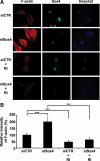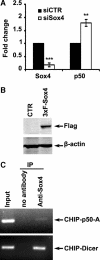Prognostic significance of Sox4 expression in human cutaneous melanoma and its role in cell migration and invasion
- PMID: 20952589
- PMCID: PMC2993272
- DOI: 10.2353/ajpath.2010.100377
Prognostic significance of Sox4 expression in human cutaneous melanoma and its role in cell migration and invasion
Abstract
The Sox4 transcription factor is involved in various cellular processes, such as embryonic development and differentiation. Deregulated expression of Sox4 in several human cancers has been reported to date, but its role in melanoma is unknown. We explored the role of Sox4 in melanoma pathogenesis in vivo and in vitro. Using tissue microarray, we evaluated Sox4 expression in 180 melanocytic lesions and investigated its role in melanoma cell migration and invasion. Sox4 expression was remarkably reduced in metastatic melanoma compared with dysplastic nevi (P < 0.05) and primary melanoma (P < 0.01). This reduction was correlated with a poorer disease-specific survival of melanoma patients (P = 0.039). Multivariate Cox regression analysis revealed that reduced Sox4 expression is an independent prognostic factor (P = 0.049). Knockdown of Sox4 enhanced melanoma cell invasion, migration, and stress fiber formation. The increased migration and invasion on Sox4 knockdown depends on the presence of nuclear factor (NF)-κB p50 and is abrogated when p50 is knocked down. We further observed inhibition of NF-κB p50 transcription by Sox4, in addition to a reverse pattern of expression of Sox4 and NF-κB p50 in different stages of melanocytic lesions. Our results suggest that Sox4 regulates melanoma cell migration and invasion in an NF-κB p50-dependent manner and may serve as a prognostic marker and potential therapeutic target for human melanoma.
Figures






Similar articles
-
Pleiotropic function of SRY-related HMG box transcription factor 4 in regulation of tumorigenesis.Cell Mol Life Sci. 2013 Aug;70(15):2677-96. doi: 10.1007/s00018-012-1187-y. Epub 2012 Oct 19. Cell Mol Life Sci. 2013. PMID: 23080209 Free PMC article. Review.
-
Sox4-mediated Dicer expression is critical for suppression of melanoma cell invasion.Oncogene. 2013 Apr 25;32(17):2131-9. doi: 10.1038/onc.2012.239. Epub 2012 Jun 11. Oncogene. 2013. PMID: 22689055 Free PMC article.
-
SOX4 promotes melanoma cell migration and invasion though the activation of the NF-κB signaling pathway.Int J Mol Med. 2017 Aug;40(2):447-453. doi: 10.3892/ijmm.2017.3030. Epub 2017 Jun 16. Int J Mol Med. 2017. PMID: 28627651 Free PMC article.
-
Prognostic significance of nuclear factor-kappaB p105/p50 in human melanoma and its role in cell migration.Cancer Res. 2006 Sep 1;66(17):8382-8. doi: 10.1158/0008-5472.CAN-05-4402. Cancer Res. 2006. PMID: 16951147
-
SOX4: Epigenetic regulation and role in tumorigenesis.Semin Cancer Biol. 2020 Dec;67(Pt 1):91-104. doi: 10.1016/j.semcancer.2019.06.022. Epub 2019 Jul 2. Semin Cancer Biol. 2020. PMID: 31271889 Review.
Cited by
-
Emerging Role of SOX Proteins in Breast Cancer Development and Maintenance.J Mammary Gland Biol Neoplasia. 2019 Sep;24(3):213-230. doi: 10.1007/s10911-019-09430-6. Epub 2019 May 9. J Mammary Gland Biol Neoplasia. 2019. PMID: 31069617 Free PMC article. Review.
-
Pleiotropic function of SRY-related HMG box transcription factor 4 in regulation of tumorigenesis.Cell Mol Life Sci. 2013 Aug;70(15):2677-96. doi: 10.1007/s00018-012-1187-y. Epub 2012 Oct 19. Cell Mol Life Sci. 2013. PMID: 23080209 Free PMC article. Review.
-
SOX4 Promotes Progression in OLP-Associated Squamous Cell Carcinoma.J Cancer. 2016 Jul 8;7(11):1534-40. doi: 10.7150/jca.15689. eCollection 2016. J Cancer. 2016. PMID: 27471569 Free PMC article.
-
Novel multiple markers to distinguish melanoma from dysplastic nevi.PLoS One. 2012;7(9):e45037. doi: 10.1371/journal.pone.0045037. Epub 2012 Sep 27. PLoS One. 2012. PMID: 23028750 Free PMC article.
-
SOX4 contributes to the progression of cervical cancer and the resistance to the chemotherapeutic drug through ABCG2.Cell Death Dis. 2015 Nov 19;6(11):e1990. doi: 10.1038/cddis.2015.290. Cell Death Dis. 2015. PMID: 26583330 Free PMC article.
References
-
- Chin L, Garraway LA, Fisher DE. Malignant melanoma: genetics and therapeutics in the genomic era. Genes Dev. 2006;20:2149–2182. - PubMed
-
- Cummins DL, Cummins JM, Pantle H, Silverman MA, Leonard AL, Chanmugam A. Cutaneous malignant melanoma. Mayo Clin Proc. 2006;81:500–507. - PubMed
-
- Gray-Schopfer V, Wellbrock C, Marais R. Melanoma biology and new targeted therapy. Nature. 2007;445:851–857. - PubMed
-
- Miller AJ, Mihm MC., Jr Melanoma. N Engl J Med. 2006;355:51–65. - PubMed
-
- Schepers GE, Teasdale RD, Koopman P. Twenty pairs of sox: extent, homology, and nomenclature of the mouse and human sox transcription factor gene families. Dev Cell. 2002;3:167–170. - PubMed
Publication types
MeSH terms
Substances
Grants and funding
LinkOut - more resources
Full Text Sources
Other Literature Sources
Medical
Research Materials

